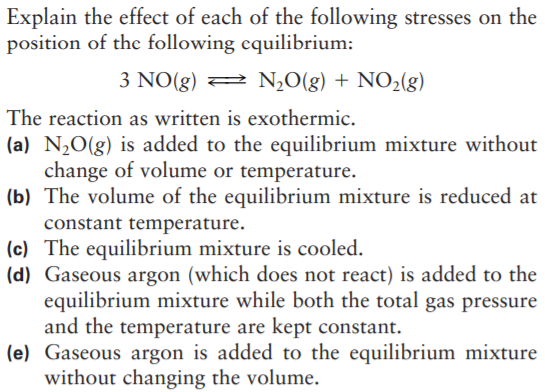Explain the effect of each of the following stresses on the position of the following equilibrium: 3 NO(g) 2 N¿O(g) + NO2(g) The reaction as written is exothermic. (a) N¿O(g) is added to the equilibrium mixture without change of volume or temperature. (b) The volume of the equilibrium mixture is reduced at constant temperature. (c) The equilibrium mixture is cooled. (d) Gaseous argon (which does not react) is added to the equilibrium mixture while both the total gas pressure and the temperature are kept constant. (e) Gaseous argon is added to the equilibrium mixture without changing the volume.
Explain the effect of each of the following stresses on the position of the following equilibrium: 3 NO(g) 2 N¿O(g) + NO2(g) The reaction as written is exothermic. (a) N¿O(g) is added to the equilibrium mixture without change of volume or temperature. (b) The volume of the equilibrium mixture is reduced at constant temperature. (c) The equilibrium mixture is cooled. (d) Gaseous argon (which does not react) is added to the equilibrium mixture while both the total gas pressure and the temperature are kept constant. (e) Gaseous argon is added to the equilibrium mixture without changing the volume.
Introductory Chemistry: A Foundation
9th Edition
ISBN:9781337399425
Author:Steven S. Zumdahl, Donald J. DeCoste
Publisher:Steven S. Zumdahl, Donald J. DeCoste
Chapter17: Equilibrium
Section: Chapter Questions
Problem 13CR
Related questions
Question

Transcribed Image Text:Explain the effect of each of the following stresses on the
position of the following equilibrium:
3 NO(g) 2 N¿O(g) + NO2(g)
The reaction as written is exothermic.
(a) N¿O(g) is added to the equilibrium mixture without
change of volume or temperature.
(b) The volume of the equilibrium mixture is reduced at
constant temperature.
(c) The equilibrium mixture is cooled.
(d) Gaseous argon (which does not react) is added to the
equilibrium mixture while both the total gas pressure
and the temperature are kept constant.
(e) Gaseous argon is added to the equilibrium mixture
without changing the volume.
Expert Solution
This question has been solved!
Explore an expertly crafted, step-by-step solution for a thorough understanding of key concepts.
This is a popular solution!
Trending now
This is a popular solution!
Step by step
Solved in 2 steps with 1 images

Recommended textbooks for you

Introductory Chemistry: A Foundation
Chemistry
ISBN:
9781337399425
Author:
Steven S. Zumdahl, Donald J. DeCoste
Publisher:
Cengage Learning

Introduction to General, Organic and Biochemistry
Chemistry
ISBN:
9781285869759
Author:
Frederick A. Bettelheim, William H. Brown, Mary K. Campbell, Shawn O. Farrell, Omar Torres
Publisher:
Cengage Learning

Chemistry: The Molecular Science
Chemistry
ISBN:
9781285199047
Author:
John W. Moore, Conrad L. Stanitski
Publisher:
Cengage Learning

Introductory Chemistry: A Foundation
Chemistry
ISBN:
9781337399425
Author:
Steven S. Zumdahl, Donald J. DeCoste
Publisher:
Cengage Learning

Introduction to General, Organic and Biochemistry
Chemistry
ISBN:
9781285869759
Author:
Frederick A. Bettelheim, William H. Brown, Mary K. Campbell, Shawn O. Farrell, Omar Torres
Publisher:
Cengage Learning

Chemistry: The Molecular Science
Chemistry
ISBN:
9781285199047
Author:
John W. Moore, Conrad L. Stanitski
Publisher:
Cengage Learning

Chemistry & Chemical Reactivity
Chemistry
ISBN:
9781133949640
Author:
John C. Kotz, Paul M. Treichel, John Townsend, David Treichel
Publisher:
Cengage Learning

Chemistry & Chemical Reactivity
Chemistry
ISBN:
9781337399074
Author:
John C. Kotz, Paul M. Treichel, John Townsend, David Treichel
Publisher:
Cengage Learning

Introductory Chemistry: A Foundation
Chemistry
ISBN:
9781285199030
Author:
Steven S. Zumdahl, Donald J. DeCoste
Publisher:
Cengage Learning